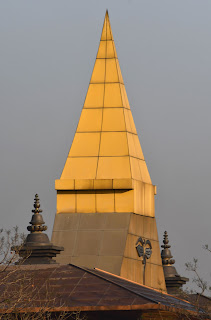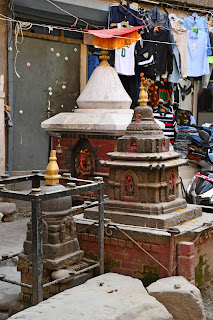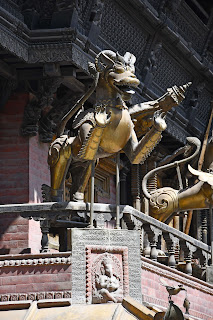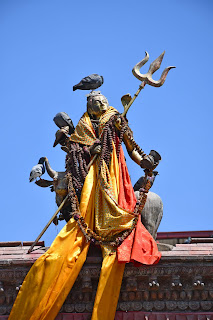Nepal – Day 1: Central Kathmandu
I will not dwell much on day 0 of this adventure: my dad and I left Prague on a Sunday afternoon, transferred in Istanbul, and touched down in Kathmandu shortly after dawn on Monday. There were two highlights to the journey. First, we found all the alcohol at Istanbul Airport had labels warning customers of a three-litre purchasing limit – but these were, hilariously, only in Russian. The second highlight was seeing the sun rise over the Himalayas. There was also a lowlight: we encountered strong turbulence on our flight from Istanbul to Kathmandu. As I am sure is true for many people, this was an opportunity for me to revisit most of the religious hymns I know.
We began our first day
in Kathmandu by checking into our hotel, where we ate a leisurely breakfast.
The rest of the tour group was supposed to arrive the next day, so we took the
opportunity to venture into the city alone. Piecing together an itinerary with
the help of the Rough Guides travel book, I had a rough idea of where to go,
though the trouble with any literature on Nepal is that it is never entirely
accurate. Perhaps most significantly, crossroads tend to have one or two extra
roads sprinkled in, which makes counting angles – rather than numbers – vitally
important.
No guide book, moreover,
could prepare us for the absolute chaos that are Nepali streets. Narrow and
packed with people, they are an anarchic domain in which cars fight vans,
motorbikes fight cars, and pedestrians fight everyone. It is impossible to
traverse the road without practically throwing one’s body into it, signalling
to drivers one’s willingness to cross or perish in the attempt. Obviously,
there are no clear lanes on the narrow roads of central Kathmandu, which creates
a jumble of pedestrians and motorbikes bustling past each other in both
directions.
Added to these
difficulties, of course, is the problem that foreigners tend to attract quite a
lot of attention. One’s concentration, therefore, is divided between trying not
to be run over on the one hand, and refusing offers from taxi drivers, deals
from hawkers, and blessings from priests – or, in the more pleasant scenario,
holding Q&A sessions with local kids.
We walked from our
accommodation in Thamel Quarter past several stupas and temples to the very
centre of the city: Durbar Square. Home to the palace of the Shah Dynasty,
which ruled Nepal from 1768 to 2008, the square charges foreigners an entry
fee, with little guard posts monitoring every street into the area. Several of
the buildings on Durbar Square were quite badly damaged in the 2015 earthquake
and have not yet been fully repaired. For that reason, access to many
interesting sites is severely limited, though we did have the chance to see
Kumari during one of her appearances at the balcony of her abode.
Dubbed a “living
goddess,” the Kumari is a pre-pubescent girl believed to be possessed by the
goddess Durga. She is revered by both Buddhists and Hindus despite being chosen
from a prominent Buddhist family through a series of rigorous tests. Although
the Kumari of Kathmandu is the most important, other children fulfil the same
role in other Nepali cities. During their tenure (which ends with their
menstruation or serious illness or injury), these living goddesses provide
blessings to the community and are truly treated the way a deity would be. They
are not permitted to walk outside, sometimes needing to re-learn how to walk
after returning to normal life – though a Kumari does receive a pension
following her retirement.
After eating lunch in
a restaurant overlooking Durbar Square, we continued southeast, walking along a
large rectangular field until we reached the Bagmati river. We were not
entirely sure what this field was; it was bare and desolate, with people only
congregating on the sides, which were shaded by trees. Towards the south, we
could spy some military vehicles and people clad in uniforms. We later found
out this was Tudikhel, an important venue for festivals, military parades, and
horse races.
We were equally taken
aback by the desolation of the river. Despite being on the Rough Guide’s list
of places to visit, the temples and Ghats along the Bagmati were completely
deserted, giving the place an eerie atmosphere despite the streaming sunshine. Adding
to this strange feeling were massive piles of wood prepared for the funeral
rites of bodies that are traditionally incinerated at these temples.
Having reached the
southern tip of our itinerary, we turned back again and – more by sheer dumb
luck than by following the map – ended up at Durbar Square and subsequently
Thamel. I think the temple I found the most impressive on this tour was the
Kathesimbhu Stupa, which dates to the seventeenth century and neighbours a
beautiful Tibetan monastery. The entire square that the Stupa occupies is beset
with various smaller stupas and statues, and adding to the charm of the place
was a group of women singing a plaintive prayer in one of the adjoining
buildings.


























































































Comments
Post a Comment